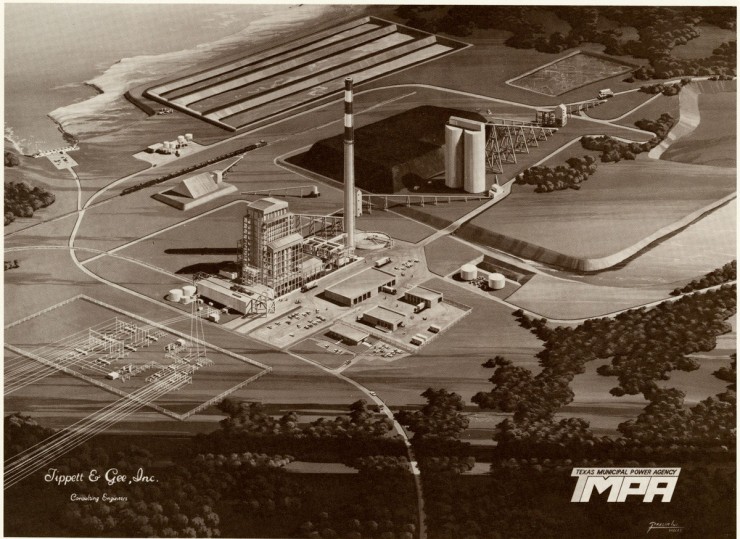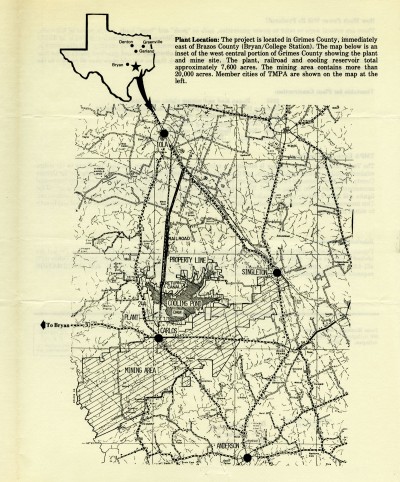
Architectural Rendering of the Gibbons Creek Power Project, taken from Gibbons Creek Power Project: Socioeconomic Effects and Community Programs, Tom Harpool Collection, UNT Special Collections.

Sign for Site of Gibbons Creek S. E. S. , taken from Gibbons Creek Power Project: Socioeconomic Effects and Community Programs, Tom Harpool Collection, UNT Special Collections.
Where would our world be without electricity? Well, we’d certainly be in the dark! It’s hard to believe now that people used to thrive with nothing but sunshine and candlelight. Cities in North Texas began to get electricity in the late nineteenth and early twentieth centuries, but its usage was very limited. In Greenville, for example, electrical use was only available in the evenings from dark until 10:00 p.m., and also on Tuesdays for women to use their electric irons.
To offset the costly business of supplying power to thousands of residents living in a city, the Texas Municipal Power Pool was formed in 1963. Original members were Greenville, Garland, and Bryan. Denton joined in 1969. The pool used the transmission systems of the Brazos Electric Power Cooperative, which allowed the cities to share a back up facility and reserve power rather than building and maintaining four individual systems. This cooperative saved millions of dollars and provided better service to residents, and the Pool became the Texas Municipal Power Agency in 1975.
As the cities of Denton, Greenville, Garland, and Bryan grew, so did their need for electricity. They needed a new energy source, and they found it at Gibbons Creek in Carlos, a small town near Bryan and College Station in Grimes County. The TMPA planned to mine 20,000 acres for lignite and to construct a plant site, cooling reservoir, and railroad spur (which would consume 7,200 acres).
Many residents in Grimes County protested the lignite mining project. The county expected a loss in tax revenues, because the tax-exempt TMPA would acquire such a large amount of land. However, the loss in revenue was quite small (less than one percent of the annual budget), and the construction of the plant would bring new residents and a drive to better housing and community services, which would cause overall improvement of economic conditions.

Map of Gibbons Creek Power Plant Location, taken from The Gibbons Creek Steam Electric Station: A Project of the TMPA, Tom Harpool Collection, UNT Special Collections.
The Gibbons Creek Steam Electric Station was in use from 1982 to 1996, when the mine was closed. The TMPA now imports its coal from Wyoming. The project site has been in a state of reclamation since its closure, and much of it has been returned to pasture, ponds, and woodlands. The methods we use for energy production and their environmental impact are an engaging topic to study today, and our 20th century decisions on this matter will surely be an important and fascinating subject for scholars in the coming decades.
The Tom Harpool Collection in UNT’s Special Collections department offers literature about the Texas Municipal Power Agency and its projects, as well as papers pertaining to the City of Denton, the Denton Utility Board, Clean Power Production and Water Conservation.
-by Alexandra Traxinger Schütz



Leave a Reply